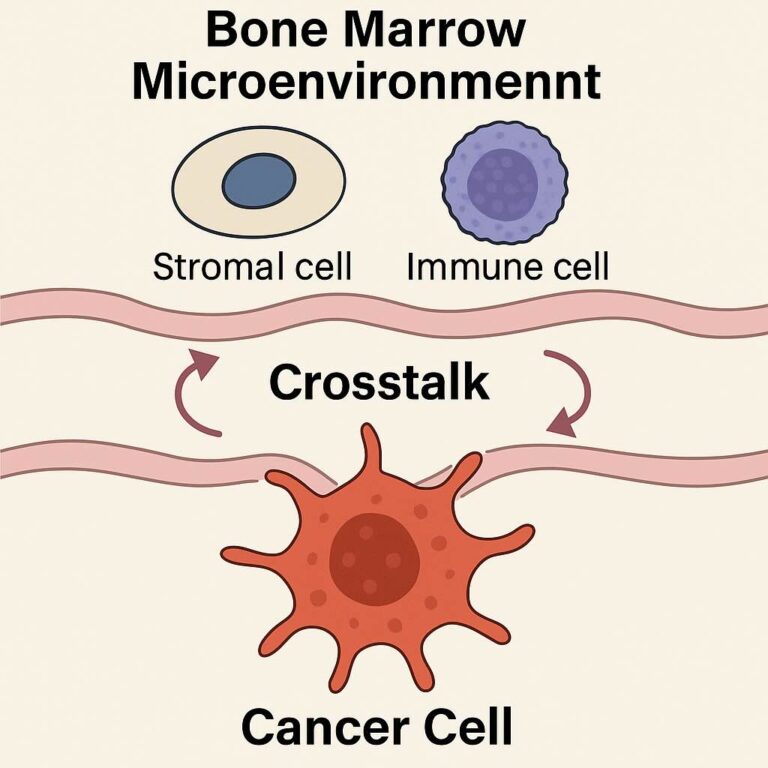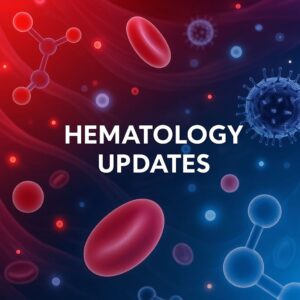How does the bone marrow microenvironment contribute to hematological disease progression and resistance to therapy?
Here are some recent scientific articles addressing this exact question.

Mesenchymal stromal cells from JAK2V617F myeloproliferative neoplasms support healthy and malignant hematopoiesis in a humanized scaffold model in vivo.
This study shows that mesenchymal stromal cells (MSCs) from JAK2V617F-positive myeloproliferative neoplasms (PV, ET) can support both healthy and mutant hematopoiesis, maintaining clonal expansion and function of JAK2V617F HSPCs in a new humanized 3D scaffold in vivo model.
Niche MSCs retain their supportive properties even in a malignant setting, with cytokine (FGF-2) signals linked to mutant clone growth.
IMPACT: This model fills a critical gap by enabling robust functional study of human MPN stem cells and stroma interactions, paving the way for targeted therapeutic research.
Inhibiting the alarmin-driven hematopoiesis-stromal cell crosstalk in primary myelofibrosis ameliorates bone marrow fibrosis.
Tasquinimod effectively targets JAK2V617F‐mutant hematopoietic cells, especially megakaryocytes and monocytes, leading to downregulation of proliferative and fibrotic pathways, induction of apoptosis, and reversal of TGFβ‐driven reprogramming.
Importantly, genetic ablation experiments revealed that S100A9 derived from hematopoietic, but not stromal, cells is crucial for driving bone marrow fibrosis and disease progression. Coculture assays further confirmed that mutant hematopoietic cells directly trigger pro‐fibrotic activation of stromal cells via S100A8/S100A9 signaling.
Collectively, these findings establish the hematopoietic clone as the key source of inflammatory alarminsfueling fibrosis.
IMPACT: This work provides a novel mechanistic insight into hematopoiesis-stroma crosstalk and highlights the therapeutic potential of targeting the S100A8/S100A9 axis to overcome the current lack of effective antifibrotic treatments in myeloproliferative neoplasms
Syntenin inhibition impairs stroma-tumor communication in multiple myeloma and improves bortezomib treatment efficiency.
Syntenin was found to be highly expressed in inflammatory bone marrow stromal cells (BMSCs) of multiple myeloma (MM) patients and correlated with poor survival.
Genetic deletion or pharmacological inhibition of syntenin altered the stromal secretome, reduced IL-6 and syntenin loading into small extracellular vesicles, and impaired activation of STAT3, MAPK, and AKT-mTOR pathways in MM cells.
This disruption abolished BMSC-induced bortezomib resistance in vitro, enhanced drug-induced apoptosis in patient samples, and significantly reduced tumor burden in vivo.
IMPACT: The study identifies syntenin as a master regulator of stroma-tumor communication and proposes its inhibition as a novel therapeutic strategy to overcome microenvironment-mediated drug resistance in MM, addressing a major gap in improving the efficacy of proteasome inhibitors.
3D Tumor microenvironment interaction reveals AP-1 complex regulation and contact-mediated reprogramming of bone marrow stromal cells in chronic lymphocytic leukemia.
Chronic lymphocytic leukemia (CLL) B cells in 3D co-culture systems were found to upregulate AP-1 transcription factor components in core regions, enhancing survival and drug resistance, while regulatory and follicular helper T cells were enriched in these niches.
Single-cell RNA sequencing revealed a novel population of contact-induced bone marrow stromal cells (ciBMSCs) with cancer-associated fibroblast-like and immunosuppressive features.
Functional inhibition of AP-1 reduced CLL cell survival and downregulated pro-tumorigenic gene expression in ciBMSCs, underscoring the central role of spatially defined, contact-mediated interactions.
IMPACT: This study uncovers AP-1-driven leukemia-stroma crosstalk as a key mechanism of therapy resistance, filling a major gap by linking spatial microenvironmental organization to novel therapeutic vulnerabilities in CLL.
Bruton tyrosine kinase covalent inhibition shapes the immune microenvironment in chronic lymphocytic leukemia.
Ibrutinib treatment in previously untreated CLL patients reduced T-cell exhaustion markers, normalized Treg frequencies, and downregulated pathways linked to T-cell activation, metabolism, and proliferation, leading to partial restoration of immune competence.
In parallel, CLL cells showed decreased expression of immunosuppressive and adhesion proteins but upregulated CXCR4, with a subset retaining migratory capacity towards CXCL12. These migrating cells frequently carried subclonal shifts, including early detection of BTK C481S mutations, and exhibited enhanced mTOR-MYC signaling.
High expression of TMBIM6 emerged as an independent poor prognostic factor, with pharmacological inhibition inducing CLL apoptosis and synergizing with ibrutinib.
IMPACT: This work uncovers early adaptive mechanisms to BTK inhibition, highlighting TMBIM6 as a novel therapeutic vulnerability and addressing the current gap in strategies to eradicate residual CLL cells under continuous BTK blockade.
